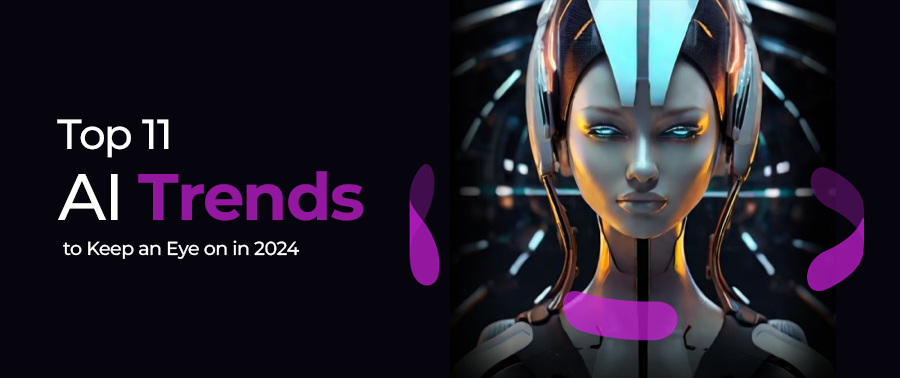Artificial Intelligence (AI) has been a transformative force, revolutionizing industries and shaping the way we live and work. From virtual assistants making our homes smarter to complex algorithms aiding in medical diagnostics, AI has woven itself into the fabric of modern existence.
As we embark on the journey of 2024, the AI realm is poised for groundbreaking developments, each trend offering a glimpse into the vast potential of this dynamic field.
OpenAI's GPT-4 and Advanced Natural Language Processing (NLP)
In 2024, OpenAI's GPT-4 is set to push the boundaries of Natural Language Processing (NLP). GPT-4's hallmark is its advanced contextual understanding, allowing it to grasp the intricacies of human language with unparalleled nuance. This means a more refined comprehension of context, enabling chatbots and virtual assistants to respond with a level of sophistication that mimics human conversation.
In practical terms, this breakthrough means that virtual assistants powered by GPT-4 will not only recognize the explicit content of a query but also discern the underlying context.
For instance, in a conversation, if a user references a previous topic, GPT-4 can maintain coherence and provide responses that are more contextually relevant. This depth of understanding brings us closer to the elusive goal of truly intelligent, context-aware AI.
Machine Learning Operations (MLOps)
MLOps represents a pivotal evolution in the technology landscape, merging the principles of DevOps with the intricacies of machine learning (ML). In essence, it acts as the unifying force that bridges the gap between data scientists and operations, fostering a collaborative environment that is essential for successful ML implementations.
Machine learning projects involve multifaceted collaboration, requiring seamless coordination between data scientists, developers, and operations teams. MLOps simplifies this complexity by providing a unified platform where these disparate teams can converge, share insights, and collectively contribute to the ML lifecycle.
Explainable AI (XAI)
In the realm of advanced AI systems, the growing complexity of models brings forth the critical necessity for transparency and interpretability. Explainable AI (XAI) emerges as a response to this challenge, striving to demystify the inherent opacity of black-box AI models. The fundamental goal is to unravel the decision-making processes encoded within these intricate systems, making them more comprehensible and accountable.
Explainability in AI is instrumental in addressing concerns related to bias and fairness. By unveiling the decision-making process, it becomes feasible to identify and rectify biases present in training data or model architectures.
This transparency is especially crucial in applications where biased decisions can have profound societal implications, such as hiring processes, lending decisions, or criminal justice systems.
Quantum Computing and AI Integration
The integration of quantum computing and artificial intelligence heralds a new era at the intersection of two groundbreaking technologies. Quantum computing, with its unparalleled processing capabilities derived from the principles of quantum mechanics, is poised to revolutionize the landscape of AI applications.
At the heart of this convergence lies quantum computing's ability to perform computations at speeds and scales inconceivable for classical computers.
One of the other prime advantages of integrating quantum computing with AI is the capacity to tackle complex problems that are currently beyond the reach of classical computers. Quantum computers excel in optimization tasks, where finding the best solution among a vast number of possibilities is inherently challenging.
In the world of AI, this capability translates to significant advancements in optimization algorithms, enabling more efficient resource allocation, scheduling, and decision-making processes.
Generative AI Models
Generative AI models, particularly in the realm of Natural Language Processing (NLP) and image generation, are reaching new heights. Expect AI systems capable of creating human-like text and images, revolutionizing content creation, design, and storytelling.
Beyond NLP, generative AI is making waves in the domain of image generation. Models like DALL-E from OpenAI showcase the ability to create images based on textual descriptions. This has transformative implications for design, visual arts, and even virtual environments.
Generative AI's proficiency extends to design tasks, where it can assist in creating visual elements, graphics, and layouts. The ability to generate images based on textual prompts opens up new possibilities for designers, allowing them to explore ideas rapidly and iteratively.
AI in Climate Science
Climate change mitigation and adaptation efforts can benefit significantly from AI applications. Predictive modeling, data analysis, and pattern recognition can help scientists understand climate patterns, predict extreme weather events, and optimize resource allocation for sustainability.
The vast amount of climate-related data available requires sophisticated analysis tools. AI excels in processing and interpreting complex datasets, extracting meaningful patterns, and identifying correlations. This data-driven approach aids decision-makers in understanding current climate conditions, assessing environmental impacts, and formulating effective strategies for climate action.
Human-AI Collaboration
Collaboration between humans and AI is evolving beyond automation. In 2024, we anticipate AI systems seamlessly integrating with human workflows, providing decision support, and enhancing creativity. This trend fosters a symbiotic relationship, leveraging the strengths of both humans and AI.
Education and training benefit from the collaboration between humans and AI through real-time adaptive learning. AI systems analyze learners' progress, identify areas of improvement, and dynamically adjust educational content. This personalized learning experience ensures that individuals receive targeted support, optimizing the learning journey and adapting to diverse learning styles.
AI Ethics and Bias Mitigation
As AI systems influence more aspects of our lives, addressing ethical concerns and mitigating bias becomes imperative. In 2024, expect increased efforts to develop AI systems that prioritize fairness, transparency, and ethical considerations, ensuring responsible AI development and deployment.
Recognizing that AI transcends borders, there is a push for global collaboration in establishing ethical standards. In 2024, expect increased cooperation between governments, industry leaders, and international organizations to define and implement ethical guidelines for AI development and deployment.
Shared standards contribute to a more consistent and responsible global AI landscape.
AI-driven Personalization
In 2024, dynamic content tailoring takes center stage, enabling platforms to adapt in real time based on user interactions. This means personalized content, be it articles, product suggestions, or advertisements, is dynamically adjusted to cater to individual preferences and behaviors.
Anticipating user needs before they express them is a key advancement in 2024. Predictive personalization engines leverage machine learning to forecast user preferences based on historical data, enabling platforms to proactively offer tailored experiences.
AI in Agriculture
Agriculture is embracing AI to optimize crop management, monitor soil health, and improve yield predictions. AI-powered drones and sensors provide real-time insights, enabling farmers to make data-driven decisions for sustainable agriculture practices.
AI-powered predictive analytics transforms crop yield predictions. By considering historical data, weather patterns, and various environmental factors, AI models generate accurate forecasts. This empowers farmers to anticipate market trends, plan harvest schedules efficiently, and optimize their overall agricultural production.
AI-Embedded Biometric Authentication
Biometric authentication, fortified by AI, will enhance security protocols. From facial recognition to voice authentication, the amalgamation of AI and biometrics ensures robust identity verification, safeguarding sensitive information.
AI's role in biometric authentication extends to behavioral patterns. By analyzing user behavior, such as typing rhythm or mouse movements, AI establishes a comprehensive understanding of individual behavioral biometrics. This multifaceted approach adds an extra layer of security, making it challenging for unauthorized users to mimic multiple biometric aspects simultaneously.
Conclusion
In the rapidly evolving AI landscape of 2024, transformative trends are reshaping our technological future. From OpenAI's GPT-4 advancing natural language understanding to Explainable AI (XAI) addressing model transparency, each trend promises significant strides.
Ethical considerations, collaboration, and a heightened focus on personalization highlight a future where AI not only enhances capabilities but operates responsibly. As we navigate the dynamic world of AI, it's a journey marked by innovation, transparency, and a harmonious integration of artificial and human intelligence, promising a future where technology serves us all.






Top comments (0)